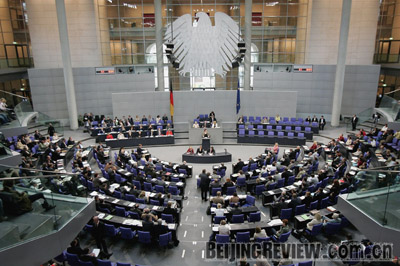|
|

|
|
AN ARENA OF OPINIONS: The German Bundestag holds a meeting in September 2006. Germany's political parties are adapting themselves to the changing times |
More than six months after the parliamentary election in Hesse State, Germany, on January 27, the five elected parties-the Christian Democratic Union (CDU), the Social Democratic Party (SPD), the Greens, the Free Democratic Party (FDP) and the Left-have yet to form an alliance for a new government because of differences in their political views. It is the first time Germany has faced such a stalemate.
In the 2003 Hesse election, the CDU won 48.8 percent of the vote and easily formed a coalition government with the FDP. This year, however, the CDU received only 36.8 percent. Theoretically, it could form a government with the SPD, which came in just behind with 36.7 percent. But the two parties' Hesse State heads are sworn rivals, making it impossible for them to enter into an alliance. As a result, they have each had to seek the support of two smaller parties to create a three-party coalition. The FDP, with 9.4 percent of the vote, holds views irreconcilably conflicting with the Greens, which claimed 7.5 percent. The CDU has ruled out any possibility of an alliance with the Left, which pocketed 5.1 percent of the vote.
The political outcome in Hesse now hinges on two options: First, the SPD and the Greens could form a minority government with the support of the Left. Alternatively, the CDU could persuade the Greens to join a CDU-FDP coalition government.
Discussions on whether to formally ally with the Left or merely seek its support instead are expected to top the agenda of the upcoming SPD congress in September. If these efforts fail, the caretaker CDU government will have to remain in office until next spring, when a new election will be held to break the deadlock.
With just one year to go before Germany's federal election next September, the Hesse standoff reflects some new trends that will have far-reaching implications for the German political world.
Five-party game
The five parties in the German Bundestag, the lower house of the country's parliament, use different colors as their symbols-black for the CDU/CSU, red for the SPD, yellow for the FDP, green for the Greens and red for the Left. The CSU, or the Christian Social Union, is the CDU's sister party that operates exclusively in the state of Bavaria.
The CDU/CSU is traditionally a conservative party. Unlike the SPD, which represents employees' interests, it tries to protect the interests of employers. While both parties vow to establish a welfare state, they disagree on how to realize this goal. The CDU/CSU believes the key to economic development lies in securing a reasonable profit margin for employers and encouraging them to expand investment. The SPD, however, argues that employees' interests should be well protected to ensure political stability and social justice before sustainable economic development is achieved.
The FDP maintains that the state should reduce its interference in the market. Its supporters are mostly high-income, well-educated Germans. The Greens, founded in 1980, stand for environmental protection and against the building of nuclear power plants. Its membership is similar to the FDP's. Their main difference is that the Greens are left-leaning, while the FDP is right-leaning. The Left, founded in 2007, upholds the political ideology of democratic socialism.
Blurring distinction
Compared with other European countries, West Germany enjoyed political stability after World War II, largely because the SPD and the CDU/CSU had stable support from their members-voters seldom switched parties. The FDP occupied less than 10 percent of the seats in the Bundestag for a long time until 1998, thus being able to form coalition governments with either of the two major parties.
|
